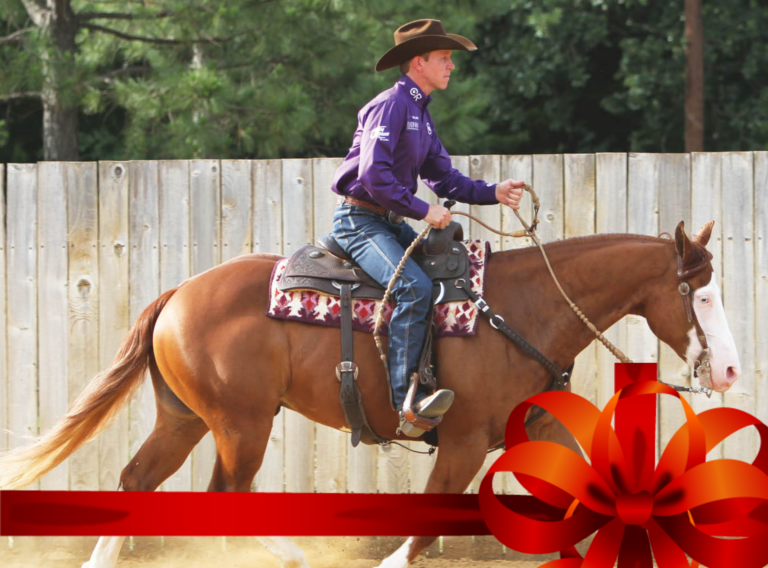Some people might disagree, but I think the art of leading has greatly diminished in recent history. When I was a young man, we learned to lead our horses ahead of us. We had some bad horses in those days that would try to bite you or get after you, so you had to lead your horse in the “safe zone,” walking with your horse beside you. This way, if one of those tough horses came after you, you could put your arm out to push him away and protect yourself.
Today, we generally have much better trained horses overall, which might make leading seem like a minuscule part of your horsemanship. Maybe you’re too busy thinking about what’s coming next as you lead your horse to the arena or trailhead to worry about him lagging behind you, pulling on the rope. But I’m here to tell you that lazy leading causes far more problems than you might imagine.
Here, I’ll explain why proper leading technique is essential for all riders and how to reboot a horse that’s developed the habit of walking behind you instead of up beside you.

The Liabilities
How you lead your horse to the arena—or even to the wash rack or saddling area—sets the tone for all you’ll do with that horse on that day. One habit begets other habits. So, if he’s lazy to walk to the arena, he’ll be lazy about getting to the mounting block, for example. Then he’ll be apathetic about the training session and schooling during your ride, or maybe he’ll slog down the trail, ignoring your cues to move forward at a faster pace.
As I mentioned to start, lazy leading can also be dangerous for a few reasons. First of all, you’re not in position to react to your horse. He’s behind you, so you can’t see what he sees, experience what he’s feeling, or anticipate how he might react to something that spooks or upsets him. If a plastic bag flies in front of you and he spins around to turn and flee, you’re in danger of being dragged along with him rather than poised to diffuse the situation. If he’s being ornery and reaches forward to nip at your shoulder, you won’t see it coming, so you can’t prevent it. These behaviors can grow into other dangerous problems, resulting from a lack of respect from your horse because you didn’t command respect when leading.
It’s so easy to avoid this by practicing good horsemanship every day. But if your horse has become lazy on the lead rope, there are ways to get him back into shape and rebuild the respect you need for a safe relationship.

Fix the Issue
To begin, you must have your mind focused on what you want. You have to be ready to put in the work and fix the problem. If you’re not fully committed, you won’t be able to change the behavior.
Think about watching a showmanship class, especially at a higher level. Those horses aren’t lazy on the lead line. They’re right there beside their handlers, ready for the next command. Visualize this type of response from your horse. I realize many showmanship exhibitors use chain lead shanks, but this isn’t required unless it’s a severe case of disobedience from your horse.
When you set off to lead your horse forward, exude forward energy—head and shoulders up, body forward and ready to move. Lead with your hand no more than 6 inches down the rope from where it attaches to the halter, with your hand forward. This helps position your horse beside you.
Start Simple and Progress
Start with a verbal cue—a cluck or a smooch—to encourage your horse forward. This association can help him be ready to walk forward immediately as he begins to put the pieces together. It also serves as a reminder of what happens next if he doesn’t move.
If your horse doesn’t move forward or lags behind, it’s time to take action. Simply pulling on him won’t do the trick. He needs encouragement to push him forward rather than you pulling. Take the tail end of your lead and swing it behind you to swat your horse on the hindquarters. Be prepared—he might lurch forward when he gets this eye-opening tap. If you’re not confident in your ability to time this correction, ask a friend to walk behind your horse carrying a buggy whip. Its length keeps your helper out of danger of being kicked when they tap your horse’s lower legs with the whip to encourage him to go forward.
Forward Movement
Once he gets going, keep moving forward! If you make him stop because you weren’t ready, you’ll undo all you’ve been working toward. Continue forward a handful of steps in the direction you choose, and then you can stop and praise your horse.
Longeing can help reinforce your work on the lead rope. By sending your horse forward and around you on a longe line, you’re teaching him to move off your body, stay a bit ahead of you, and respect your commands.
As you work through these steps, use a progression of pressure. Begin with body language, add a voice command, and finish with a physical encouragement forward, if necessary. Then continue to work on it! Leading is something we should all practice with our horses to make them better partners. Every horse that leads well is a better horse because of it. If he leads responsively, he’s much more likely to ride responsively, too.







